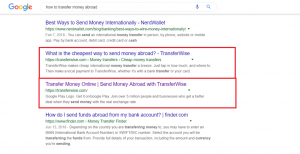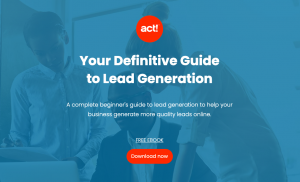Content marketing can help your business reach its goals. However, before starting to create content, it’s important to put in place an effective content marketing plan.
In this article, we’ll show you how to develop a content marketing strategy by breaking the process down into the following steps.
- Define your content marketing strategy goals
- Define your buyer persona
- Decide on the types of content you will produce
- Decide where you will publish your content
- Create an editorial calendar
Read on for more information about each step.
1. Define Your Content Marketing Strategy Goals
The most important part of creating a successful content marketing strategy is to define your goals.
Without clearly defined goals, you have no way of knowing if you are succeeding in your strategy. This may ultimately lead you to waste time creating ineffective content.
Below, we’ll look at some of the common reasons brands create content. Of course, it’s also possible that you may have multiple goals. For example, you may want to both build brand authority and drive traffic to your website.
Build Brand Authority
When building brand authority, you’ll need to create content that provides original insight into your industry.
This can be through reports, surveys, or through sharing the unique knowledge or opinions about your industry. If the content you publish is interesting enough people will link back to it and you’ll become an authority in your industry.
A good example of this is App Annie, a platform that provides data on smartphone apps.

Part of their content marketing strategy is publishing reports and data about app trends. These reports are regularly picked up by technology news websites which link back to the report on the App Annie website.
This has helped make the company one of the most trusted names in the app data industry.
Increase Exposure on Search Engines
SEO is one of the number one reasons websites create content. It’s probably also one of the most misunderstood.
Ranking highly on Google requires a lot more than simply writing articles about things people search for.
Instead, you’ll need to spend time searching for keywords that you have a chance of ranking for. You then write highly optimised content targeting these keywords. You’ll also need to spend a lot of time gaining backlinks to increase the trustworthiness of your website. Check out our list of free SEO tools that can help you with your keyword research.
When you begin your SEO strategy, you’ll have the most success with long-tail keywords that don’t have much competition. However, as your business grows and your website authority increases, you’ll be able to target keywords that can drive more visitors to your site.
There are plenty of great examples of companies with effective SEO strategies. International money transfer app TransferWise is a favourite of ours.
It has a ton of great content informing people about how to transfer money abroad and it ranks well on Google. Look at the screenshot below to see what happens when you search for “How to send money abroad.” Two of the top results are from the company.

Generate Leads
A common way to use content to generate leads is to offer a report, case study, eBook, course, or white paper in exchange for the lead’s contact details.
The key thing to do here is to create a piece of content that is compelling and useful enough for people to want to hand over their details to access it.
At Act! we offer our website visitors a beginner’s guide to lead generation that helps businesses create more quality leads online. You can download the guide here.
2. Define Your Buyer Persona (or Personas)
The second step to creating an effective content marketing strategy is to define the type of people you will aim your content at. This will most likely be your ideal buyer persona, a fictional representation of the type of people you want to target.
If you don’t already have a buyer persona, you’ll need to make one. To help you with your buyer persona, we have provided a persona template that you can use to easily create your own personas.
Information you can include when creating a buyer persona includes:
- Biographical data such as age, gender, location, industry, income, interests, etc.
- Problems potential customers have that your solution could help solve.
- Goals that your product could help push the customer towards.
- Challenges that your buyer persona will have to overcome to buy your product.
You can get this information from existing customer data, website analytics, competitor analysis, or market research surveys. Once you know this information, it will help you with all parts of your content strategy including the type of content you produce and where you publish it.
For example, if you want to generate leads targeting middle-aged professionals, you may find it is a good idea to write blog posts or case studies on LinkedIn. Alternatively, if you want to raise your profile amongst millennials, it could be a good idea to make daily posts on Instagram.
For more information about who uses different platforms, then take a look at Pew Research’s report into social media usage in 2019.
3. Plan the Types of Content You Will Produce
You then need to decide which type of content you will produce. This will be something that will appeal to your buyer persona while pushing you towards the overall goals of your content marketing strategy.
Types of content you could produce include:
- Blog posts – Blog posts are probably the most common type of content website’s produce. This is because they can be effectively used to boost SEO and they can be quicker and cheaper to produce than videos, case studies, etc.
- Videos – Videos are another common type of content. Producing videos can take longer than writing blog posts and it can be more expensive if you don’t already have the required equipment. For more info, here is our guide to video content marketing.
- Case studies – Case studies will generally be used to show how your product can help businesses overcome a specific problem. By using a real-life example, they effectively show how great your product is.
- Infographics – Infographics and images can be used to highlight statistics about your product or industry. The great thing about them is well-designed infographics that contain useful data can be highly sharable.
- Online courses, games, etc: Content comes in many forms. Businesses have used everything from games to courses, to apps, to entire websites as part of their content marketing plan. Really, you can produce anything you think will help with your business goals.
It’s worth noting that some of your content ideas will work well in many different categories. For example, if you have a great idea for a blog post, you may also find that you can convey the same idea through a video or a podcast.
Additionally, a well-designed infographic will often benefit from a blog post to dive into some of the ideas in further detail. If you produce a case study, you could later split the findings into a number of blog posts and then use them to encourage people to download the full report.
An example of a mixed content strategy is a recent study by SEO tool Ahrefs that compared Wix SEO to WordPress. They used the results to produce an in-depth blog post, plenty of graphics showing data from the study, and a YouTube video.

4. Where Will You Publish Your Content?
At the same time as you decide what type of content you’ll produce, you should also think about where you will publish it. You should consider your existing platforms (if you have any), as well as the places your buyer persona is likely to visit.
A key conflict here will likely be between whether to publish the content on your own blog or via a third party. After all, if you are just starting out you probably don’t have many people coming to your website, which means publishing content there could result in not many people reading it.
On the other hand, if you publish everything on third-party sites like YouTube and Medium, you’re never going to build up your own audience.
Perhaps the best thing to do here would be to use a combined strategy. For example, you could initially publish some of your authoritative blog posts on sites like Medium or LinkedIn, and then publish SEO optimised content on your website.
5. Create an Editorial Calendar
The final step is to put all the information you have gathered into use by creating an editorial calendar (also known as a content calendar). This will contain a plan of all the content you will create and publish over a set time period.
The calendar will include information from the categories above, such as where you will publish the content and what the goal of the content is, as well as practical information such as who will write it and when you will publish. Essentially, it will keep your content marketing efforts organised.
Wrapping Up
Taking the time to develop a content marketing strategy will help you produce better content and get it in front of relevant people. This can help you achieve your ultimate goals, both in terms of content and in terms of your business. We’ve produced a handy content marketing plan template that helps you put your content marketing strategy into action. You can download it here.







